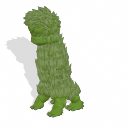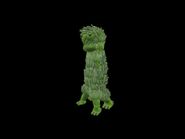NOTE: This page's content isn't canon to Dinoman972's main fiction, nor to the Fiction Universe in general.
“Yeah, but- Wait, it's actually A PLANT? Great, first Godzilla and now this one.”
- - Dinoman972's reaction to Creepers being actually plants
Common Creepers, also known simply as Creepers, were a mobile floridate species native to planet Earth, which is now extinct. They originated from the very popular sandbox indie game Minecraft.
History[]
Creepers evolved from primitive species of peat moss around the year 65,000,000 BC, when a large meteor hit Earth and threatened many local species with extinction. While many of these species survived without changing much, others saw themselves to quickly develop in order to survive the mass extinction, with locomotion abilities and a more effective reproduction syste,. The new creature, known as Creeper, inhabited Earth during the following millenia until eventually dissapearing in the 22nd century, due to humans in the planet considering them a threat and hunting them to extinction. There are theories about Creepers having survived the holocaust, but no proof has been found.
Biology[]
Physical description[]
Most Creepers were nearly as tall as humans, measuring around 1,625 meters in height. They were quite light, with the largest known individual measuring 50 kilograms in weight.
Creepers had an odd shape, with an upright body ending in four small legs, and a monstrous, humanoid head with hollow eyes. Despite looking reptilian in nature, Creepers actualy had the same composition and body structure as plants, with the different parts of their body having evolved from those of a member of the Sphagnum genus: the head is actually the capsule which contains the spores, while the legs evolved from roots.
There was no known sexual dimorphism in the Creeper species.
Habitat[]
Creepers can inhabit most parts of planet Earth, including deserts and cave systems, but usually prefers dark forests and jungles, where their skin camouflages in the enviroment.
Behavior[]
Creepers, like its plant relatives, obtained water and nutrients from the ground. During daytime, Creepers would have their legs buried in the ground, absorbing water and nutrients. When it was nighttime, however, Creepers would unbury themselves and start moving, looking for a "host". When they found a large enough creature, they would walk to it and, using a combination of the popgun mechanism already used by its ancestors and chemical reactions inside its body, explode with moderate power, releasing spores in the air. These spores would stick to the target and, when it died (if not dead already by the explosion), the spores would obtain nutrients from the corpse in order to grow. If there were other creatures around the Creeper when it explodes, the spores might stick to them too. Once their roots are unearthed, Creepers will constantly look for a host until they explode, even if it becomes daytime and they haven't found one yet. This often causes the Creeper to starve, as it cannot obtain nutrients while it looks for a host.
Curiosly, it is also known that Creepers usually fled from many feline species on sight, mainly ocelots and house cats. The reasons for this are unknown, but theories suggest the Creepers flee from animals smaller than them because they are harder to "infect". Another unexplainable trait of the species is their "hissing", usually produced before exploding. Theories suggest this is an unvoluntary action, produced during the chemical reactions inside the Creeper's body.
Ecology[]
Despite being plants, Creepers occupied a quite high niche in the food chain, since their explosive powers made most herbivores afraid of eating them. Their only natural dangers were humans, which would often kill them in order to protect themselves. This is the reason Creepers were hunted to extinction, thus no longer occupying the slot in the ecosystem they used to.
Taxonomy[]
Creepers have been taxonomically classified as floridates belonging to the Plainatina family. Appearance-wise, their closest relatives seem to be the Swamp Willenbaurrows and the Golden Willenbaurrows.
In Dinoman972's personal system, Creepers have their own family: Creperidae. This family includes all different Creeper species, such as the common one shown in this page. This family is in the class Sphagnales, which they share with three other families. The family Sphagnaceae, including all peat mosses of the genus Sphagnum, includies their closest relatives.
The Creeper's binominal name is Crepere ekrikticos. The genus name was found on another wiki, and presumably refers to the creature's name; the epithet, on the other hand, means explosive in greek.
Quotes on them[]
“Yeah, but- Wait, it's actually A PLANT? Great, first Godzilla and now this one.”
- - Dinoman972's reaction to Creepers being actually plants
“These lanky lime horrors will gaze upon you with a look of utmost sadness. You'll soon have a similar facial expression, if you let it get close.”
- - Tom Stone, one of Minecraft's developers, on Creepers
Gallery[]
Downloadable PNGs[]
Other pictures[]
Trivia[]
Behind the Scenes[]
- In the original game, Creepers came to be due to a modelling error during the making of the pig.
- The concept of Creepers as plants in this page, as well as many other of the aspects shown here, are based on a theory proposed in the YouTube channel GameTheory.
- Creepers were initially thought of as some sort of surviving sauropod species by Dinoman972, until he discovered the theory about them being plants.
- Due to the mouth part used for them, Creepers are actually carnivores ingame.
Other trivia[]
- Creepers are the first Re-Creation posted by Dinoman972 in the wiki.
| |||||||||||||||||||||||||||||||||||||||||||||||||||||||||||||||||||||||||||


